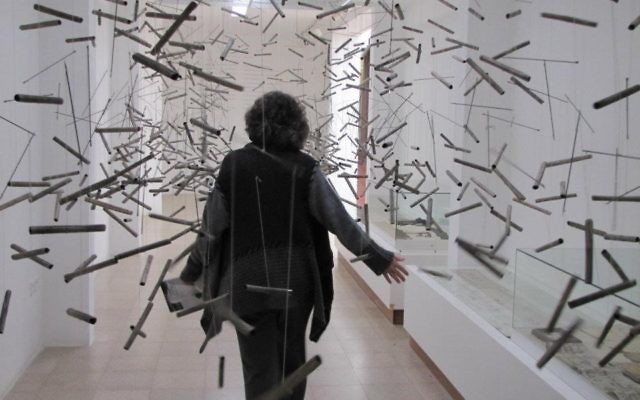Mikvah Artist Arnovitz Shares Mural Vision
By R.M. Grossblatt
Former Atlantan Andi Arnovitz is painting a mural that will be a featured element in the new mikvah at Congregation Beth Tefillah. The mural will incorporate drawings women made during a design and launch event for the facility in January.
Arnovitz talked to the AJT about her art and how she got involved with the Beth Tefillah project.
—
AJT: When did you first get interested in art?
Arnovitz: I have been making art forever. My degree is a B.F.A. from Washington University. Even as a little girl, I was always drawing and making things. My mother took me to museums my entire childhood, had me taking classes, and so art has been a big part of my life and has been an ongoing inspiration as well.
AJT: What media do you use, and what special pieces have you made?
Arnovitz: Until about a five or six years ago I basically worked with either paper or fabric. I am a printmaker. Recently, though, my work has expanded to doing large-scale installations and more sculptural works, and so I use porcelain a great deal, as well as polymer resins, feathers, silk, glass and other industrial-based materials.
AJT: What area of art do you feel the most passionate about?
Arnovitz: My work today is very political. I deal with the places where gender, politics and religion meet. My website gives a good representation of these kinds of works: www.andiarnovitz.com. My favorite thing is to create pieces which are interactive. For example, for the Jerusalem Biennale of Jewish art this last fall, I filled a room with hundreds of suspended steel rods, from which fragile clay scrolls were balanced. If people paid close attention, they realized that the two clay scrolls were related to one another. One was a page from halacha, and the other was an article from the newspaper. For example, one was the halachic source for redeeming the captive, and the other was a story about Gilad Shalit. Or the halachic sources for who is required to go to war and the new Haredi draft laws. And on and on.
In order to continue through the exhibition, people had to try to walk through this without breaking anything. The entire installation became a metaphor for the country — a place founded on Jewish law but a place where real life butts heads with those very laws on a daily basis. The goal is to move forward delicately, severing neither Jewish law nor the needs and wills of the individual.
AJT: How did you get involved in doing the mural for Beth Tefillah’s new mikvah?
Arnovitz: As a past, very involved member of Beth Tefillah, I care very much about the growth of the shul and feel very sentimental about it. We are still in close contact with Dassie and Yossi New, our rabbi and rebbetzin and dear friends, and when Dassie asks me to do something, I can’t say no.
AJT: How are you incorporating the women’s art from their kickoff event?
Arnovitz: So it is hard to explain, but there is a very complicated printmaking process that is very similar to lithography. I call it Xerox lithography, and it allows me to print copies of anything — copier copies with colored lithography inks. By rolling colored inks on paper and then playing with the colors, I can create rich and varied pieces that become a rich tapestry of color and form. I intend to take the drawings, doodles and prayers the women wrote and then make panels with these. They won’t look like the originals, but when the women look closely, they will see their own handwriting, their own prayer, their own art as a part of the whole.
AJT: What is your vision for how the mural will affect the women of the community?
Arnovitz: I tend to view the entire mitzvah of mikvah as a spiritually transformative one. I have always felt that the waters of the mikvah are chock-full of women’s prayers — their gratitude and their pleas. Clearly the energies of the women using it make it much more powerful than just a pool of water. So my hope is that, first of all, there will be a bright spot of color and texture in the mikvah, as well as a literal tapestry of hopes and dreams and blessings — a communal effort. The art could not exist without the members; the mikvah could not exist without the community.
AJT: Will you bring or ship the artwork to Atlanta?
Arnovitz: I will ship it, and there will be a tightly drawn template for how to mount it. Hopefully, I will be there sometime this fall and help to hang it.
AJT: When did you make aliyah, and how has living in Israel affected your family and your work?
Arnovitz: We have lived in Israel since 1999. Israel has affected everything. Everything. My art, my kids, my worldview, my family. Having sons, sons-in-law and daughters in the army, losing people you know to terror attacks, celebrating Yom Kippur as an entire nation, living with a Jewish clock. … Israel gets under your skin and inside your head. The best way to explain it is to say that when we lived in America, whatever I read in the newspaper always seemed to happen to someone else, somewhere else. Here, everything is personal. Deeply, incredibly personal.




comments